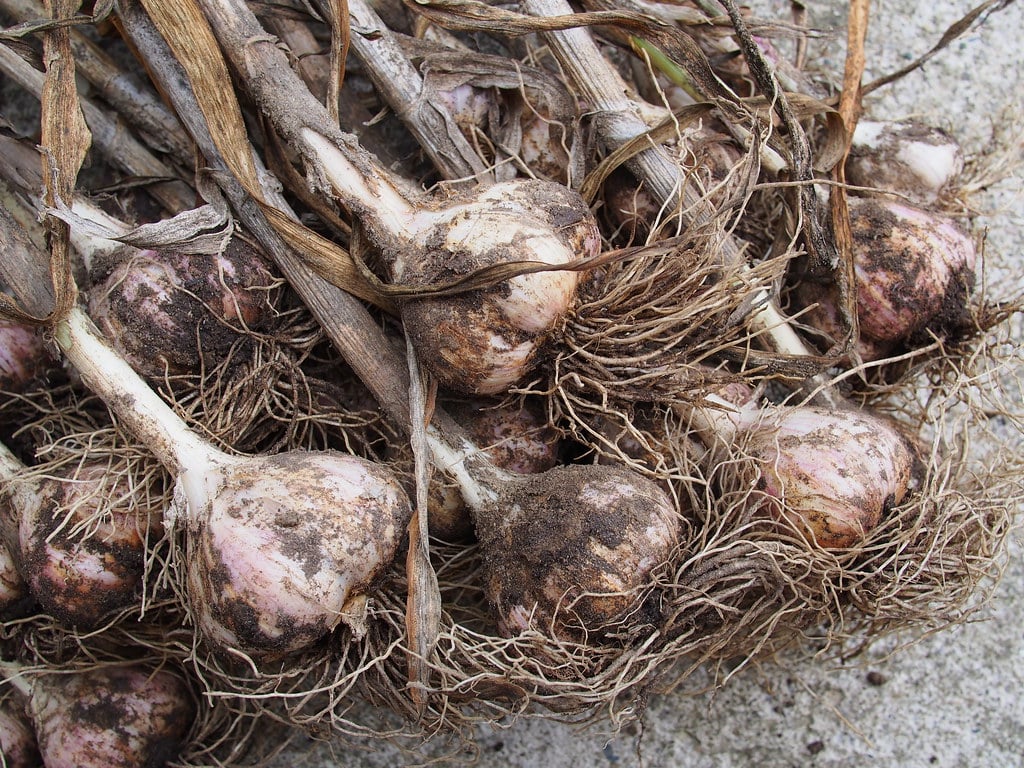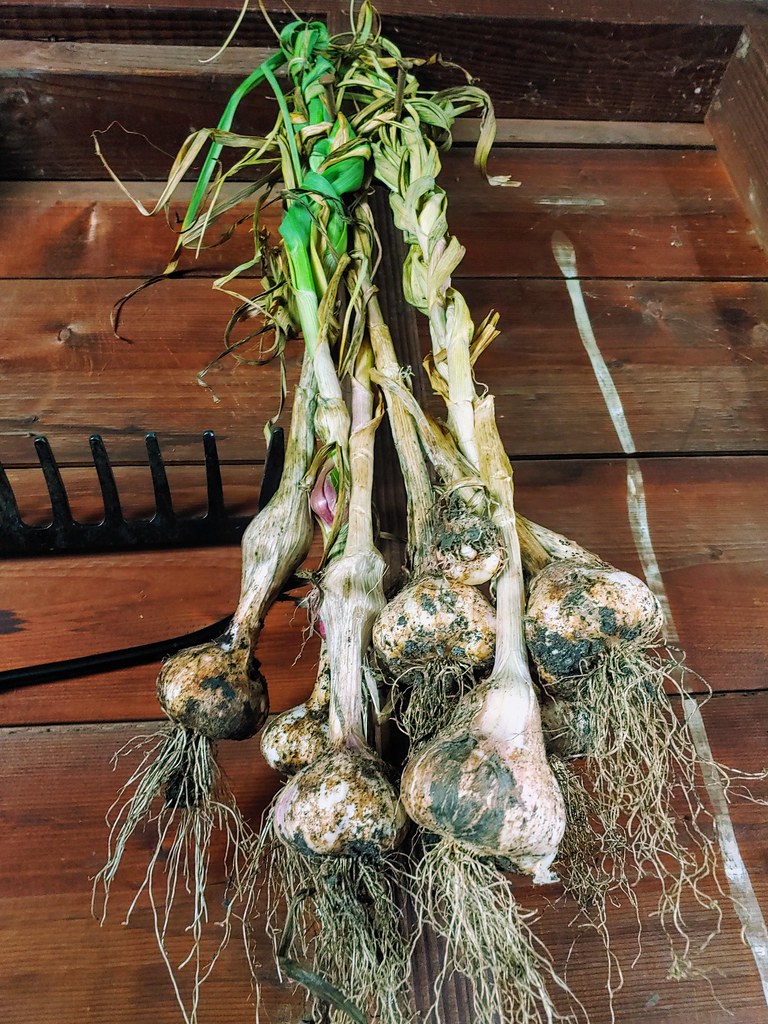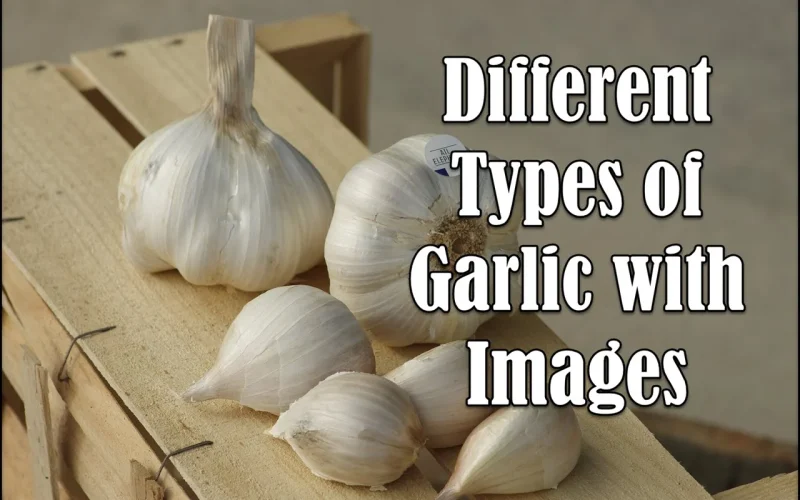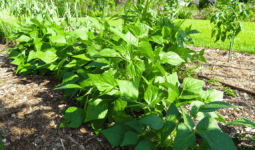Garlic is one of the healthiest and most versatile ingredients you can cook.
It’s packed with antioxidants, helps boost your immune system, and can even help lower blood pressure! But did you know that there are different types of garlic?
Therefore, we’ll discuss the most common varieties to give you a head start on your cooking.
Next time, this will help you whip up an Italian or French dish.
1. Hardneck Garlic

These are also known as stiff neck or Italian garlic and are some of the most common at grocery stores.
Their flavor is more robust than that of soft neck varieties, and they have a slightly firmer texture than the other types of garlic.
Hardnecks tend to store longer but are trickier for home gardeners to grow.
2. Softneck Garlic

Most people consider this when they think of the different types of garlic we have. The cloves are relatively large and have a very easy-to-peel skin.
It’s perfect for slicing or mincing because it doesn’t hold up well in long cooking processes like roasting or frying.
However, it retains its flavor well and makes excellent spreadable garlic butter! Softneck garlic can be stored for 3–6 months.
3. Spring Garlic
While closely related to garlic, spring garlic is often called green garlic because it’s harvested while still young.
You can also treat it like a scallion. This is one type of garlic among many.
It can be served raw in salads or cook them for a milder version. Moreover, you can prepare it at home as your favorite restaurant dish.
Spring garlic sells as a root, but you can separate and replant each clove.
4. Garlic Scapes
These are shoots that grow from garlic bulbs during summer. They don’t have gloves, so they aren’t as strong as regular garlic but boast tons of nutrients.
You can use them in a variety of ways. They can be used raw in salads, stir-fried, or even pickled. The scapes taste best when they’re still green.
However, if you want to buy these different types of garlic, look for tight, closed buds at the supermarkets for freshness.
When cooking with scapes, keep them whole. Get all those nutrients intact!
5. Chesnok Red Garlic
This is not readily available in supermarkets. Nevertheless, you might be able to find it at the specialty shops.
According to Correll, it’s described as having a rich and hearty spicy flavor without being hot.
The Russian Red has a slightly higher amount of antioxidants than other types.
Its health benefits, for instance, are lowering cholesterol levels or helping with blood pressure issues. Cooking with Chesnok Red Garlic helps your body absorb nutrients better.
You can try mixing it with different types of garlic in soups or stews during colder months! Its harvest season comes around October and November.
Then, you can buy fresh, homegrown garlic from some farmer’s markets.
6. Elephant Garlic
While elephant garlic looks more like a head of conventional garlic than its cousins, it’s technically not a different type of garlic but a form of onion.
The elephant variety is milder and sweeter than other types of garlic. It is excellent for roasting, grilling, or sautéing. It can also be eaten raw.
But take note: It does not contain cloves, so you’ll need to slice it up before using it in recipes, especially if the recipe calls for minced or chopped garlic.
This type of garlic is recognizable by its large size and spicy taste.
7. Porcelain Garlic
This garlic is all about color. For example, you can find red, white, and black garlic cloves on their regular white cloves. It can have different varieties and can contain up to 17 variations.
Among other different types of garlic, these are mainly grown for their looks and can be eaten raw or used in sauces.
However, they may still have a slightly bitter flavor compared to other types. But that’s easy enough for you to fix—add some honey.
This type of garlic is available year-round. But the disappointing part is that it’s not always widely available at every grocery store. If you want to get it, you have to check at your local farmers’ market first.
8. Georgian Fire Garlic
Though it’s not widely known, Georgian Fire garlic is a South Caucasus variety with less heat than others. So, if you want more garlic flavor with less kick, Georgian Fire is for you.
Moreover, these different types of garlic have an easily recognizable appearance and aren’t hot.
It is a perfect choice for roasting or use in raw preparations such as dressings and vinaigrettes. It also retains its flavor well when cooked.
The only caveat is that Georgian Fire doesn’t keep long—it should be used within ten days after harvest. But hey, if you like fresh ingredients, why wouldn’t you use them in your dishes?
9. Purple Stripe Garlic
A relative newcomer on the garlic scene, the purple stripe is gaining traction for its sweetness and spice.
As you might guess from its name, it’s prized for its reddish-purple hue and distinctive flavor. Furthermore, when we have these different types of garlic, among others.
However, the bulb can be used in everything from salsa to dressings. Cooks say it is most popularly used as a substitute for shallots.
Purple stripe may not be widely available yet (at least when stocked at your local grocer).
At the same time, you can find it through Amazon or specialty produce sellers like Melissa’s Produce.
10. Artichoke Garlic
Also known as French garlic, these have tightly packed cloves that resemble little artichokes.
They’re excellent for roasting and making pickles and relishes. This different type of garlic is a late-summer or fall crop.
The larger varieties are great for storage with bulbs usually weighing between 4 ounces and 2 pounds each. This garlic originated in Spain but now comes from California.
This is where growers can grow artichokes without interference from European beetles (which love garlic).
These bulbs taste nutty and mild when roasted or baked. Likewise, they are also excellent when chopped fine and added to foods while cooking.
11. Creole Garlic
As its name suggests, Creole garlic is native to Louisiana and is known for its larger cloves.
At the same time, it’s not always easy to find other different types of garlic outside of Cajun cuisine.
This garlic has a distinct sweet taste that some say resembles a banana. Studies have shown that creole offers significant cardiovascular benefits.
12. Kettle River Giant Garlic
This is one of the largest garlic varieties in existence. It’s often known as tree garlic because it grows so large that the tops can reach 6-8 feet.
They originated in Manitoba and were bred for their hardiness, size, and milder flavor. However, this makes them perfect for growers new to growing garlic.
The bulbs are great for storage, and they are ideal if you live far from where other garlic varieties grow. A single bulb weighs about 2 pounds and has 10-15 cloves.
This type of garlic isn’t easy to find among many different types of garlic. The best place to get it would be a local market.
Similarly, you can also find it online through garden stores like Burpee or Gardeners Supply Company.
13. Red Toch Garlic
Toch’s large cloves make it one of the most versatile garlic varieties. It has a mild flavor, making it ideal for raw preparations.
This garlic is often grown in China and South Asia. It can also be found in other parts of Asia, Europe, and North America.
It matures within ten months, making it an excellent storage option.
Red Toch is used medicinally to help treat stomach ailments, including high blood pressure, constipation, gastritis, and gastroenteritis.
In addition, this particular type is different from other different types of garlic. It induces sweating during a fever and eases pain caused by bronchitis and whooping cough.
14. Black Garlic
Once you’ve tried black garlic, you might never return to eating plain or white garlic again.
Unlike other types of garlic, which come in powder and silver forms, black garlic is sweet-tasting.
In addition, it’s kind of like a balsamic vinegar and soy sauce mixture. It has a slightly sticky texture that makes it easy to spread.
Black garlic can be added to pizza or blended into pesto. It can also be used as a marinade for meats or seafood. It adds a layer of flavor that makes food taste better!
15. Susanville Garlic
Susanville garlic has fewer sulfur compounds than other varieties and has a mild flavor.
It’s also known for its high germanium content, an antioxidant blend that helps reduce blood pressure and cholesterol.
These, out of other different types of garlic, are typically roasted and used in spreads, syrups, and marinades.
Conclusion
Garlic is one of those ingredients that can add so much flavor. Unfortunately for some people, it can cause some severe issues as well.
That’s why it’s essential to know how to identify the types of garlic we are using.
Suppose you want to know your garlic when you buy it. There are three main ways to identify it: looking at the cloves, smelling it, and tasting it.
Different types of garlic will usually have different-sized cloves, with an average of about six millimeters wide or more extensive (typically).
Second, smell: Some classes have a strong odor, and others are milder. When minced or chopped up, their aroma should become much more substantial.
Finally, taste!








